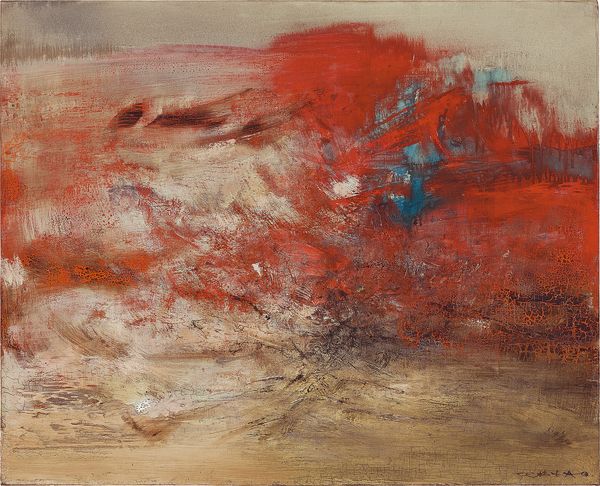Zao Wou-Ki 29.05-31.10.68, 1968. Estimate HK$28,000,000 - 38,000,000.
20th Century & Contemporary Art Evening Sale at Phillips Hong Kong, 24 November.
Over the course of the 1960s, Zao Wou-Ki’s international fame reached unprecedented levels as his painting underwent an important formal transformation. Over the course of the decade, his French gallerist—Myriam Prévot at Galerie de France— expanded the artist's reach by organizing exhibitions in galleries and museums abroad, among them a major retrospective of 64 paintings that took place in 1965 at the Museum Folkwang in Essen. Samuel Kootz, a New York dealer and champion of Abstract Expressionism, exhibited Zao’s works in the USA from 1958 until 1966 when the gallery closed, giving Zao valuable exposure to Abstract Expressionist art. Together with Chan May-Kam, his second wife, Zao traveled intensively and engaged with the most successful living painters across Europe and the USA, becoming an integral part of the artistic intelligentsia during this decade.
Joseph Mallord William Turner The Burning of the Houses of Parliament, circa 1834–5. Collection of the Tate Modern, London © Tate, London 2019
During this period, Zao’s style reached a new level of maturity. Balancing the virtues of Western painting in color and tone with the essence of traditional Chinese ink landscapes from the Song and the Yuan Dynasties, Zao evokes the four elements and natural phenomena. The English Romantic painter Joseph Mallord William Turner was also an important source of inspiration for 20th-century Chinese artists including Zao, Chu Teh-Chun and T’ang Haywen (Zeng Haiwen). As seen in his most famous series, The Burning of the Houses of Parliament, Turner’s works focused increasingly on the atmospheric qualities of sky, sea wind and fire, paving the way for the Impressionists and ostensibly influencing Zao’s unique treatment of light and atmosphere, particularly in his works from the late 1960s and the early 1970s:
"His progression is the same as J.M.W. Turner’s, the eye and hand returning again and again to the same spot. Subjects become themes, the laboratories in which pure light is distilled, an epiphany of colors following the thread of the world back to creation. (…) What is offered to view is the apotheosis of light. I find a deep affinity between these two artistic pursuits, Turner’s and Zao Wou-ki’s, which took place more than a century apart" (Dominique de Villepin, ‘Into the Labyrinth of Light’, Zao Wou-Ki, 1935-2010).
In the present work, Zao’s vigorous brushwork illustrates the battle between the four elements: fire, earth, air and water. To balance this epic encounter, the painting is divided into three horizontal bands which give a sense of stability to the central swirling composition. If the 1950s were associated with the Oracle Bones period and the appearance of signs in Zao’s works, in the 1960s Zao starts to pursue his calligraphic experiments in a different manner, recreating the atmosphere of ink paintings by adding turpentine to thin out the heavy consistency of his oil paints and to create highly translucent layers with a visual effect akin to the flowing smoothness of ink applied by the Chinese masters onto rice paper. As such, the lower part of the work illustrates the traditional ink painter’s textured brushstrokes. Also visible in the lower right quadrant, is the use of the cunfa technique (‘crack technique’) whereby a tilted and loaded ink brush layers thick, broad strokes in order to evoke shadows and texture, often used to render nature itself. In the present work, Zao has grasped the possibilities of the Chinese ink tradition and recast them with a sense of immediacy using a Western medium.
Zao Wou-ki’s achievement lies in the fact that he, as a Chinese artist, brought up immersed in Oriental art forms, was able to draw from his own cultural foundation as well as the boldness of Western Modernism. Zao’s paintings fulfilled Western expectations of the imagined East, but at the same time Zao was celebrated in China for his approach and his interpretation of Western abstraction. To achieve such bewitching works of art, Zao unites the spirit of both worlds, casting “his signs onto the canvas like so many divination sticks; he shows us the cracks in the fiery shells of tortoises, his spells, by twists and turns, close in on us in these paintings” (Dominique de Villepin, ‘Into the Labyrinth of Light’, Zao Wou-Ki, 1935-2010).

